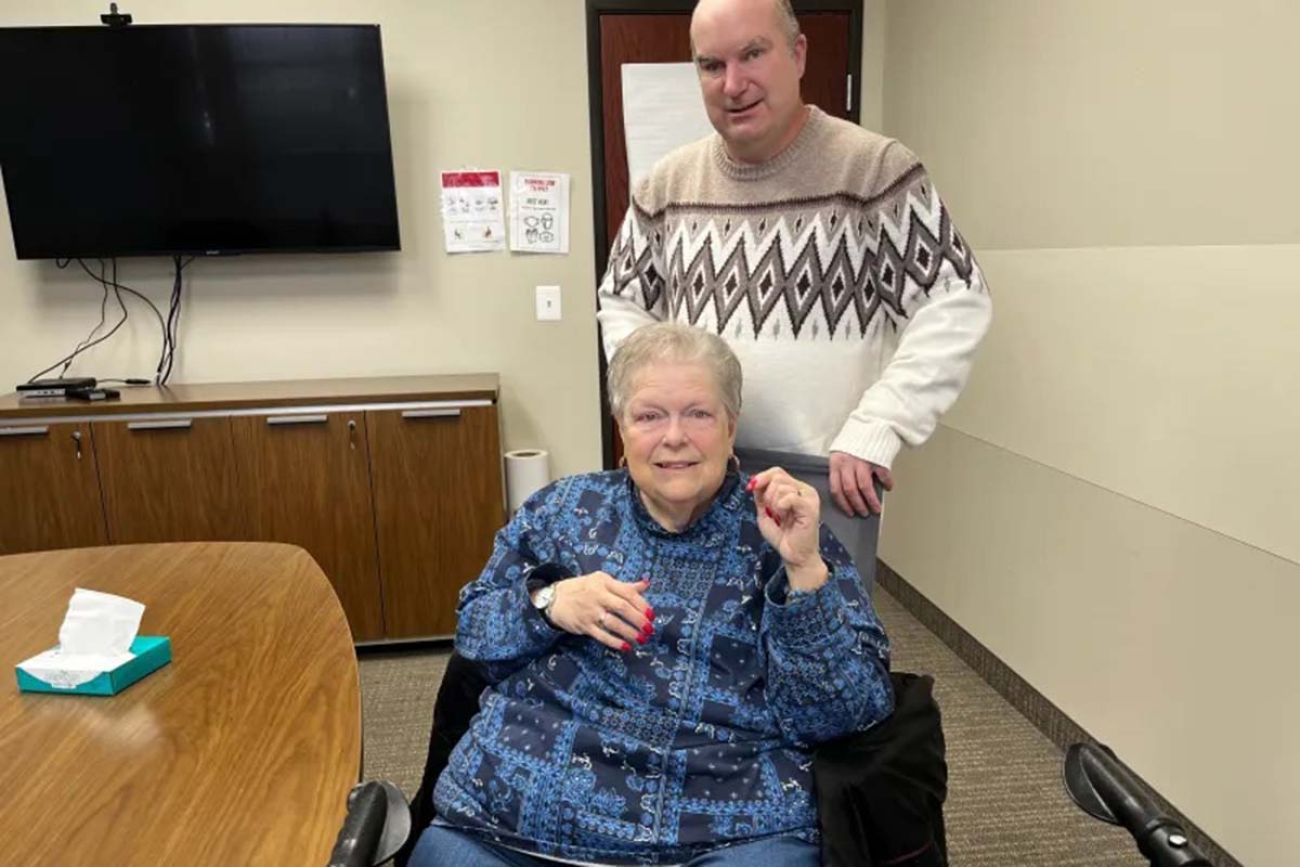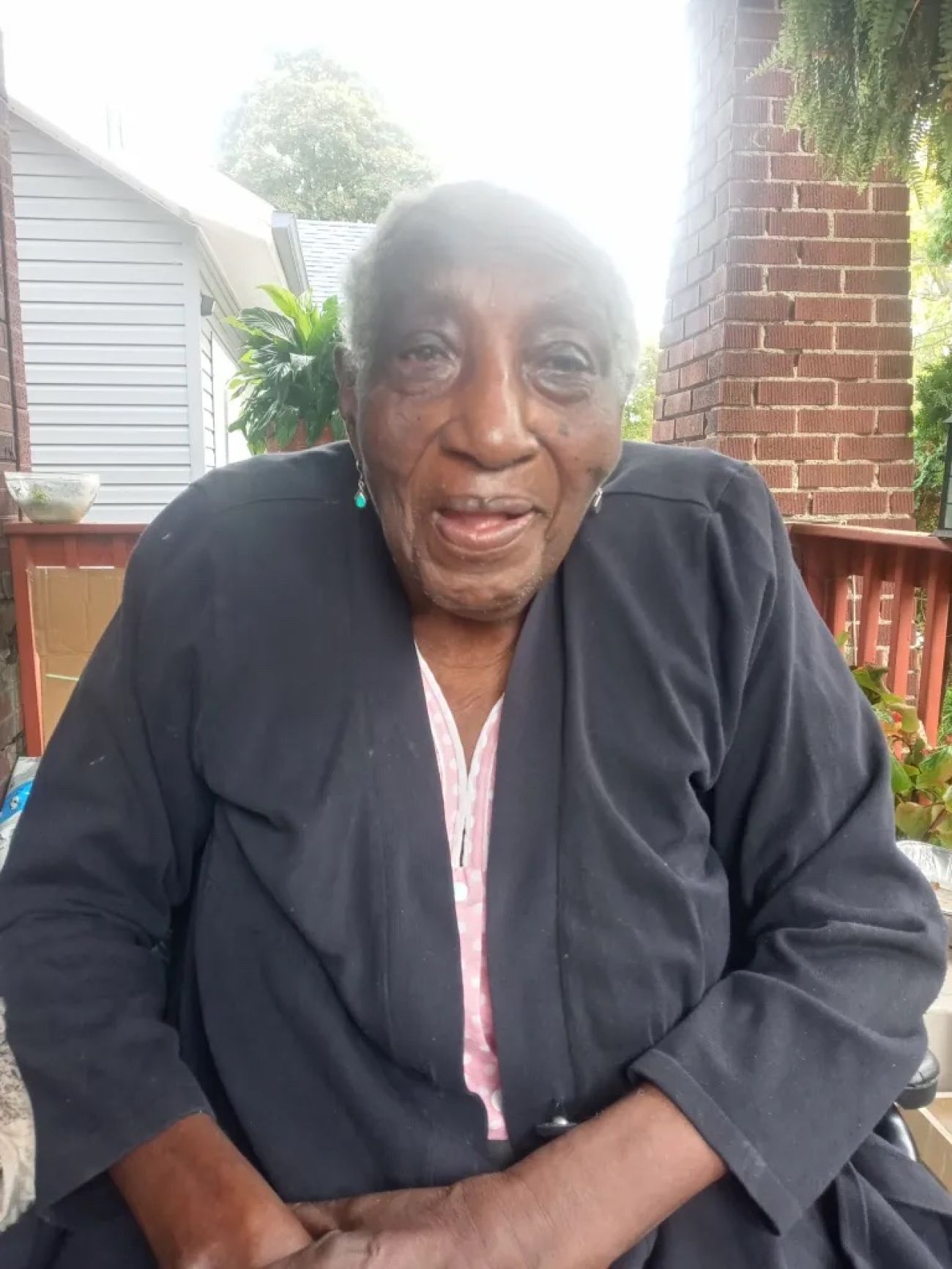Program offers familiar setting for elderly, respite for caregivers in Michigan

Four days a week, Judith Wright pushes her walker to board a bus that takes her to a bustling Sterling Heights center where she mingles with friends, sees her doctor and healthcare team, eats two hot meals and works out in a physical therapy session to build her walking and balance.
Most days, Wright’s first stop at the PACE Southeast Michigan program is the Green Room.
This article is part of Overloaded and (Often) Unpaid, a joint solutions journalism project on caregiving and mental wellness between the Southwest Michigan Journalism Collaborative and the New York and Michigan Solutions Journalism Collaborative, a partnership of news and community organizations dedicated to rigorous and compelling reporting about successful responses to social problems. The groups are supported by the Solutions Journalism Network.
“We call ourselves the party people,” said Wright, a 76-year-old widow who lives with her 50-year-old son, Darrin Letzring, in Shelby Township. She holds up a wrist with a bracelet she made with the Green Room bunch. Her ceramics and Senior Olympics medals for horseshoe and balloon tossing make her son wonder just how many more shelves she might need to hold them.
Related:
- Caregivers need help. Michigan is slowly finding a way
- Military veteran caregivers are like 'the best friend to the vet'
- Michigan's unpaid, overworked caregivers reaching a breaking point
Through PACE, Wright, a diabetic with anemia and limited mobility, has received all kinds of free help — adult incontinence products, an electric lift chair, a bed rail, eyeglasses and other accommodations. She takes 17 medicines, all free through the program. “In six years I haven’t even bought an aspirin,” she said.
PACE centers also have a health clinic and an urgent care center, as well as home services and other free items many Medicare plans may not cover.
“If we had to pay for everything they’ve given us, we’d be living out of my car,’’ her son said.
After a rare recent hospitalization for her anemia, the team came to Wright’s home, as it does for many of its participants.
Wright, a mother of three, worked more than 30 years outside her home, first as a beautician and later as an accounting department employee — but not enough to give her substantial savings. She, herself, has been a caregiver several times. Her son recalls growing up with his grandma in the same house. “It’s just what I learned,” he said.
His mom’s time at the center gives him a needed break and allows him to work part time as a Dollar Store cashier. Still, his caregiver job is substantial, though he shrugged it off. “She took care of me until I was 18, and now it’s my turn.”

PACE: A 50-year-old program yet still relatively unknown
PACE — Program for All-Inclusive Care for the Elderly — dates to 1973 in San Francisco when concerns among Asian families, who viewed nursing homes as an unacceptable solution for their aging elders, prompted the opening of an adult day care program, with other services. The idea caught on, slowly.
In 1994, southeast Michigan became one of the first pilot projects in the PACE program, as part of the Henry Ford Health system. Henry Ford Health now owns 55 percent of PACE Southeast Michigan; Presbyterian Villages of Michigan owns 45 percent.
PACE’s metro Detroit regional programs serve 1,600 older adults at seven centers — Dearborn; Eastpointe; Pontiac; Southfield; Sterling Heights; and two in Detroit, in Rivertown and on the northwest side.
An eighth center will be added this year in Clinton Township, and a ninth is planned next year for Westland.
Currently none of the Southeast Michigan centers have waiting lists, though the Sterling Heights program is at capacity.
Statewide, Michigan has 14 PACE programs at 24 centers. To find a PACE program in Michigan: https://www.michigan.gov/mdhhs/doing-business/providers/providers/other/program-of-all-inclusive-care-for-the-elderly-pace.
New York has nine PACE programs, including three in the Buffalo area and one in Rochester.
Nationwide, there are 273 PACE programs in 32 states. To find PACE programs elsewhere: https://www.npaonline.org/pace-you/pacefinder-find-pace-program-your-neighborhood
Surprisingly, even though it’s been around 50 years, the PACE program often remains unknown. It’s one of countless resources older adults and their families may sort through — and often miss — looking for help so their loved ones can continue living at home.
The biggest drawbacks of the PACE program are that applicants must be certified as frail enough to qualify for nursing home care and participation is largely for those with limited incomes, though any Medicare recipient can apply and pay for the program at $4,100 or more a month, depending on where they live.
More than half of the older adults in PACE programs have incomes below $29,650 a year; 25 percent live on even less — about $17,000 a year. Nearly half of the people coming to the PACE Sterling Heights center are so-called dual eligibles — people 55 or older who meet qualifications for both the Medicare and Medicaid programs. The average participant is a 76-year-old woman who is single, divorced or widowed without a big savings account to cover medical needs and emergencies — just like Wright.
By enrolling in PACE, a person moves all of their health insurance to a PACE program. PACE combines payments from Medicare, Medicaid and private pay sources to pay for the services it provides.
Research shows that PACE programs, though costly because they cover so many services, provide a higher level of care that keeps older adults out of nursing homes and hospitals, said Mary Naber, CEO of PACE of Southeast Michigan.
A summary of several academic research studies about the PACE program published in the academic journal Geriatrics in 2022 said that PACE participants had lower rates of hospital use and shorter lengths of stay in hospitals compared to other programs, and tended to live longer than patients who were cared for in nursing homes.
“We have a whole team that wraps their arms around them and keeps them from going to the hospital,” Naber said. “That’s where the quality improves, when they stay in their homes.”
By its very nature, PACE also supports caregivers. Academic research illustrates that support for caregivers can improve their emotional well-being. A study conducted in Spain and reported in The Journal of the Economics of Ageing in October 2022 found that direct support for home care as well as financial subsidies to pay things such as lost wages both contributed to lower incidence of depressive symptoms for caregivers. Similarly, in a commentary published by the National Institutes of Health, University of Utah sociologist Rebecca Utz wrote that “When provided consistently and in sufficient doses, respite is associated with positive outcomes for both patient and caregiver,” including reduced caregiver burden.
PACE makes house calls with wraparound services
Though participants ideally participate in programs at PACE centers, many can’t. Nearly half have some stage of dementia. Then, PACE brings its team and resources to a person’s home, as it does for Gracie Anderson, 96, of Detroit.
“Miss Gracie,” as her family calls her, is a double amputee from diabetic complications and has dementia. Until her second leg amputation in 2018, Anderson lived alone in her northwest Detroit home. One of her four daughters, Virginia Stevens, lives with her; Jacqueline Lawler, 65, her youngest daughter, is her legal caregiver and accompanies her to all her medical appointments or makes the arrangements for them.
Free diapers were the lure that convinced Lawler that PACE was just what the family needed because her mom’s Medicare plan didn’t pay for them and she was rejected by Medicaid for them. A leadership development consultant with a doctorate degree, Lawler started searching the Internet and found PACE.
“They sent out an occupational therapist and a physical therapist and then I took her to the PACE Dearborn clinic for an exam,” Lawler recalled. “This is where I got hooked. At the clinic, they found an open wound on her buttocks, likely from her wheelchair. They also sent a worker to her home to clean and care for the wound until it healed. She taught my sister how to clean the wound. The PT put a sock on the back of her wheelchair so it was comfortable. They assessed what she needed and made sure she got what she needed until she was in a place where she was stable.
“Every time I took her to the clinic, they’d ask: ‘Is she taking her [dietary supplement] Ensure and how many a day?’ “How many do you need?’ ‘Are you having challenges getting her food?’ ‘Do you need anything?’ The focus is on her overall care and her overall health. She has not been back in the hospital’’ since she entered the program in 2018, Lawler said.
A cigarette smoker until recently, Miss Gracie awakes late. Once her vitals are assessed, her diabetes medicines administered and she’s cleaned, dressed and fed, she watches TV, often westerns and dozes in her favorite chair in front of her living room window.
Lately, Lawler is not sure her mom always recognizes her. That adds to the physical and mental stress she feels.
The stress she feels would be worse, she said, if she didn’t have an entire team at PACE to watch out for her.
“It’s vigorous to be responsible for an adult parent whom you always have known to be the strongest and who now totally depends on you,’’ she said. “Not only for their daily care but for all the medical choices and everything else. It gets weary because you are paying them attention all day but then you’re not sleeping well at night. It’s a burden but one you bear.
“The weariness shows up every day. You need release. You need time away. That’s the other mental weariness. You’re always concerned about her. It gets to be overwhelming sometimes. The weariness is the demand on your time, on your mind, on your body. It’s mentally and physically exhausting,’’ she said. “Some days, I’ve just gone in the bathroom and cried and cried.”
She called some family members “non-helpers’’ because they don’t provide much help, a common source of stress to caregivers.
She and her sister switch off so they can take a vacation or get a break. PACE also provides respite programs that might place participants into approved senior facilities so caregivers can take a vacation or get a break.’’
Neither Lawler nor Letzring have used that option.
Asked when he last took a vacation, Letzring looks puzzled just hearing the word. “At least 10 years,’’ he said. But he insisted: “It’s not that stressful to me.’’
While his mother attends PACE programs, he does household chores, even his mom’s laundry. They get meals delivered several times a week through the program.
The biggest relief he feels is financial, he said, pointing to the services and necessities his mom receives for free.
Lawler considers her job caring for her mother the best way to thank her for the sacrifice Miss Gracie made. Telling the story moves her to tears.
Gracie and her late husband, who died in 1980, adopted her and her three sisters when they found the children were being neglected.
“She was God’s gift to me. He sent me to her. So He sent me, and my sisters too, a gift. What I do is my gift back to her.’’
She fully expects her mother to be able to live out her life at home.
If she can’t, PACE has relationships with nursing homes, including the Green House Project, a national model that strives to provide older adults with small living facilities with care teams assigned round-the-clock to residents.
“We generally like people to die the way they wish,” Naber said. “Many die in their home with comfort care. Some may go into a hospice program.’’ Social workers help carry out advanced care directives and other end-of-life requests.
“Most of the people we care for have not had proper care all their life,’’ Naber said. “What PACE does is provide all that they need in a true relationship model where they can grow to trust what we do. Most of them never have had that kind of care.’’
See what new members are saying about why they donated to Bridge Michigan:
- “In order for this information to be accurate and unbiased it must be underwritten by its readers, not by special interests.” - Larry S.
- “Not many other media sources report on the topics Bridge does.” - Susan B.
- “Your journalism is outstanding and rare these days.” - Mark S.
If you want to ensure the future of nonpartisan, nonprofit Michigan journalism, please become a member today. You, too, will be asked why you donated and maybe we'll feature your quote next time!




